The Cambridge History of China. Vol. 12: Republican China, 1912-1949, Part 1
Подождите немного. Документ загружается.


EVOLUTIONISM IN REFORM THOUGHT 323
of Chinese society. No longer educated for office, intellectuals more and
more stood outside the mainstream of political power; educated more
and more according to foreign models, they risked losing the inherited
language which could form a bridge to the common people.
The
discovery
of
the
West: reformist
evolutionary cosmo/ogy
Intellectual change after the 1890s must first of all be studied in the light
of the Chinese 'discovery of the West' - not merely as the source of im-
perialist aggression or technological wizardry, but as a world civilization
in its own right. At first this discovery was the result of the transmission
to a broader elite of knowledge accumulated by a few pioneers after the
1800s. The important reform study societies of the years 1895-8 began by
propagating the works of treaty-port publicists and compradores like
Wang T'ao and Cheng Kuan-ying, or of early envoys to Europe like
Hsueh Fu-ch'eng and Kuo Sung-tao; or of Christian missionary educa-
tion societies and the early Chinese arsenal schools for technological
'self-strengthening'. However, compared with the flood of energy aroused
by the reform movement
itself,
these early explorations of Western learn-
ing soon seemed limited indeed. Pushed by political exile and pulled
by the lure of the new education, thousands lived and studied abroad after
1900,
and returned to China to claim positions as intellectual leaders. For
those who remained at home, translations - especially of works on world
history, geography, politics and law - were increasingly available, at
first mainly from Japanese but later from European languages as well.
Pioneer Chinese translators like Yen Fu, who specialized in British and
French social and political philosophers, and Lin Shu, who was famous
for European romantic fiction, were among the most popular authors of
their generation. In Peking in 1895 members of the radical Study Society
for Self-Strengthening (Ch'iang-hsueh hui) organized by K'ang Yu-wei
had not been able to find a world map in any bookshop in the city. By
1919 the capital's reorganized Peking University under the chancellorship
of Ts'ai Yuan-p'ei (trained both at the Hanlin Academy and at Leipzig
University) employed graduates of Western universities, and included
courses in European literature, history, science and philosophy.
Facts like these have led to a widespread assumption that the reform
generation was stamped by the Chinese 'response to the West', and must
be analysed in terms of the impact of foreign ideas upon native systems of
thought. Fung Yu-lan, a leading neo-traditional scholar, has typically
characterized the period between the 1890s and the 1920s as one of Chinese
infatuation with the 'spiritual civilization of the West' - to be distin-
Cambridge Histories Online © Cambridge University Press, 2008

324 INTELLECTUAL CHANGE, I985-192O
guished from both the Sinocentrism
of
the dynastic era and the critical
neo-traditionalism
of
the 1920s
and
1930s.
1
Chinese Marxist historians
like Hou Wai-lu have linked this presumed infatuation with the West
to
structural changes
in
the society
-
the drive
for
industrialization
of
an
emerging bourgeoisie, which, like its European counterpart, found the
scientific and democratic ideology
of
the Enlightenment
a fit
form
to
express their socio-economic aspirations.
2
The American scholar Joseph
Levenson was more impressed with evidence suggesting that Chinese
reformers viewed the West and its intellectual claims with
a
good deal
of ambivalence,
but
interpreted
the
latter
as an
expression
of
tension
between their commitment
to
universal values
-
which dictated
the
necessity
of
adopting new beliefs from abroad
-
and their particularistic
sense
of
national cultural identity, which tugged them towards the com-
forts of tradition.'
The notion
of
'response to the West' does indeed call attention
to
the
critical importance
of
Western imperialism as an external force motivat-
ing the desire to change, and to the enormous stimulus, both positive and
negative, generated by this first serious Chinese exploration
of
dominant
nineteenth-century Western traditions
of
science
and
socio-political
thought. One danger in the concept, however, is its tendency to suggest
that the process was one of linear substitution
of
'Western' ideas for na-
tive ones; and that Chinese played an intellectually passive role. Another
is
to
foster the assumption that once the process
of
Westernization had
occurred, it was impossible for Chinese thereafter to maintain any authen-
tic commitment to traditional values. The notion that the Chinese moved
reactively from
the
assertion
of
traditional values before 1890
to
their
denial in the course of the campaign for
a
'new culture' in 1919 has been
a consequence of this explanatory model.
An alternative perspective is first suggested when one distinguishes the
political occasion behind
the
reform movement from
its
intellectual
content, and so can recognize native sources of inspiration for the latter.
Increasingly scholars have noted that comparatively heterodox move-
ments
of
traditional thought
-
whether
the
anti-despotism
of
the late
Ming loyalists
of
the seventeenth century, the individualism
of
the Lu-
Wang tradition
of
Neo-Confucianism,
the
social humanitarianism
of
Mahayana Buddhism, the libertarian strands in Taoism, or the pragmatic
and utilitarian approach to statecraft of
a
Mo-tzu, a Yen Yuan, or even the
1 Fung Yu-lan, Hsin
shih lun
(New culture and society).
2 Hou Wai-lu, Chin-tai
Chung-kuo ssu-hsiang hsueh-shuo
shih (Interpretive history
of
modern
Chinese thought).
3 Joseph R. Levenson,
Confucian China and
its
Modern
Fate.
Cambridge Histories Online © Cambridge University Press, 2008

EVOLUTIONISM IN REFORM THOUGHT 325
Legalists - were all
points
d'appui upon which many reformers built their
cases.
The imperial orthodoxy had concealed the diversity of the Chinese
tradition more than it had destroyed it, and not all native traditions -
elite or popular - were conservative ones. On the other hand, it is also
increasingly understood that China's own neo-traditional philosophers
and their Maoist adversaries alike have been correct in saying that com-
mitment to Confucian values survived the iconoclastic onslaught of the
'New Culture' and May Fourth movements, and has continued to guide
the social behaviour and spiritual life of many Chinese down to post-
Liberation times.
Nonetheless, the 'response to the West' model of intellectual change
is only partially challenged by an analysis which perceives continuities,
like discontinuities, as historically linear. A more fruitful approach may
be to recognize that the leading thinkers of the reform generation were
trying to understand how both continuities and discontinuities fit into
significantly altered structures of
meaning.
The socio-political struggle for
reform was not articulated in isolation, but within the framework of a
new evolutionary cosmology. This was a systemic conception of the
universe, in which natural, spiritual and social phenomena were perceived
as manifestations of a single cosmic reality. The external source of this
new cosmology lay in the Chinese discovery of what they took to be new
truths of nature and facts of history revealed by the West. On the one
hand there was the discovery of
a
world history encompassing a plurality
of high civilizations in dynamic interaction with one another as well as
with a 'barbarian' perimeter; on the other, there was the exploration of
the implications of Western scientific law - particularly the laws of evolu-
tion based upon Darwinian biology, but also those of Newtonian physics
as well. Internally the cosmology relied upon the Confucian-Taoist
tradition which taught that socio-political phenomena and natural cosmic
patterns are linked in
a
process of interdependent causation. There resulted
from the new cosmology a world-view which took away from Chinese
their self-image as the sole source of world civilization, and exposed them
as members of one culture and one nation among many. But at the same
time the consequent relativization of China was no simple cutting down to
size - rather it implied the relativization of all cultures, all social stages,
and all points in historical time. It resulted in a new faith in world-histori-
cal progress among Chinese, but one which stressed both the moral tele-
ology of the historical process and its relative incompleteness at any
given temporal stage. This in turn led to a reemphasis upon time
itself,
in the classic sense of 'change' (/') as a metaphysical reality - the cosmic
energies at work directing all the structures of existence in their ultimately
Cambridge Histories Online © Cambridge University Press, 2008
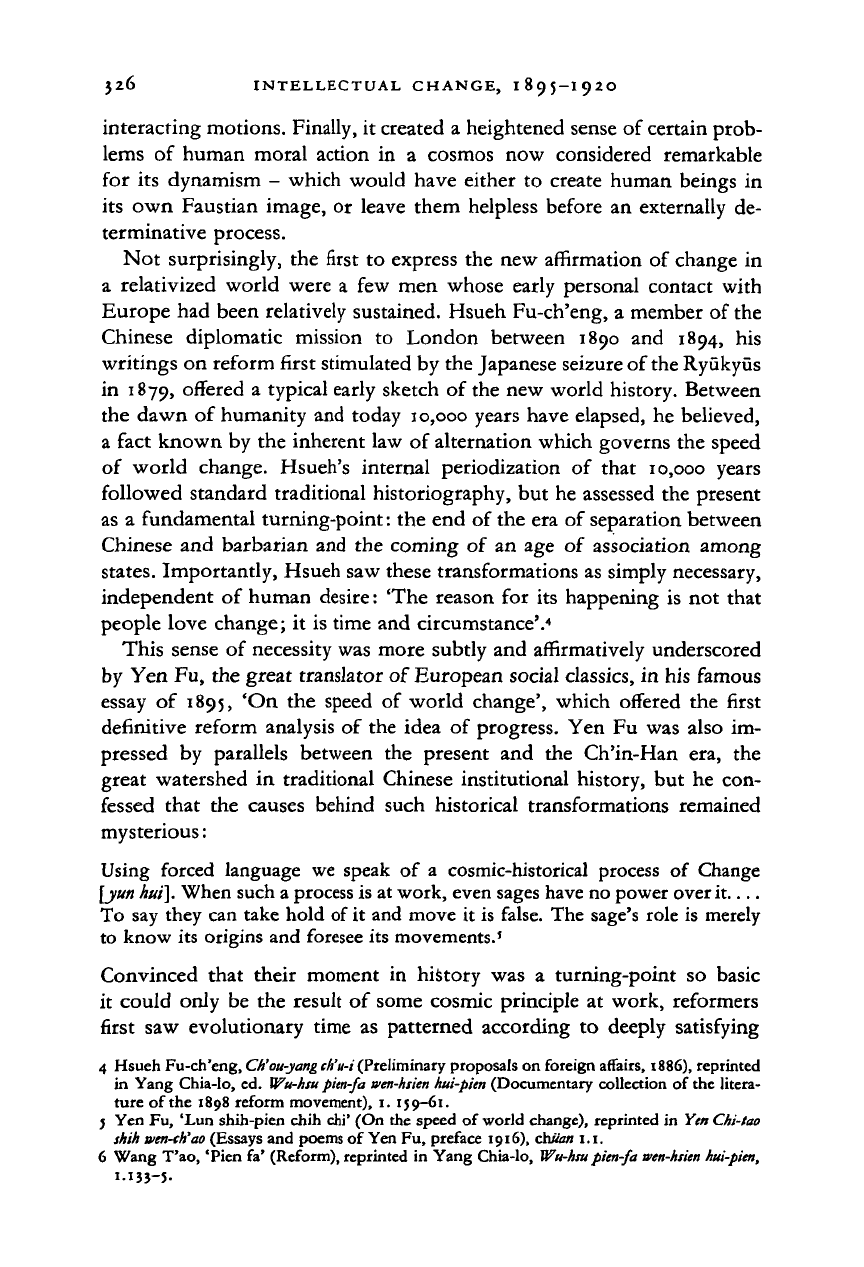
326 INTELLECTUAL CHANGE, 1895-I920
interacting motions. Finally, it created
a
heightened sense of certain prob-
lems
of
human moral action
in a
cosmos now considered remarkable
for its dynamism
-
which would have either
to
create human beings
in
its own Faustian image,
or
leave them helpless before an externally de-
terminative process.
Not surprisingly, the first to express the new affirmation of change in
a relativized world were
a
few men whose early personal contact with
Europe had been relatively sustained. Hsueh Fu-ch'eng,
a
member of the
Chinese diplomatic mission
to
London between 1890
and
1894,
his
writings on reform first stimulated by the Japanese seizure of
the
Ryukyus
in 1879, offered
a
typical early sketch of the new world history. Between
the dawn of humanity and today 10,000 years have elapsed, he believed,
a fact known by the inherent law of alternation which governs the speed
of world change. Hsueh's internal periodization
of
that 10,000 years
followed standard traditional historiography, but he assessed the present
as
a
fundamental turning-point: the end of the era of separation between
Chinese and barbarian and the coming
of
an age
of
association among
states.
Importantly, Hsueh saw these transformations as simply necessary,
independent
of
human desire: 'The reason for its happening
is
not that
people love change;
it
is time and circumstance'.
4
This sense of necessity was more subtly and affirmatively underscored
by Yen Fu, the great translator of European social classics, in his famous
essay
of
1895, 'On the speed
of
world change', which offered the first
definitive reform analysis
of
the idea
of
progress. Yen Fu was also im-
pressed
by
parallels between
the
present
and the
Ch'in-Han era,
the
great watershed
in
traditional Chinese institutional history, but he con-
fessed that the causes behind such historical transformations remained
mysterious:
Using forced language we speak
of a
cosmic-historical process
of
Change
\jun
hui\.
When such a process is at work, even sages have no power over it....
To say they can take hold of it and move it is false. The sage's role is merely
to know its origins and foresee its movements.'
Convinced that their moment
in
history was
a
turning-point
so
basic
it could only be the result
of
some cosmic principle
at
work, reformers
first saw evolutionary time
as
patterned according
to
deeply satisfying
4 Hsueh Fu-ch'eng,
Ch'ou-yang ch'u-i
(Preliminary proposals on foreign affairs, 1886), reprinted
in Yang Chia-lo, ed.
Vfu-hsu
pitn-fa
aen-hsien hui-pien
(Documentary collection
of
the litera-
ture of the 1898 reform movement),
1.
159-61.
5 Yen Fu, 'Lun shih-pien chih chi' (On the speed of world change), reprinted in Yen Chi-tao
shih
wen-eh'ao
(Essays and poems
of
Yen Fu, preface 1916), chi/an 1.1.
6 Wang T'ao, 'Pien fa' (Reform), reprinted in Yang Chia-lo,
Wu-hsu pien-fa wen-hsien
hui-pien,
1.133-5.
Cambridge Histories Online © Cambridge University Press, 2008
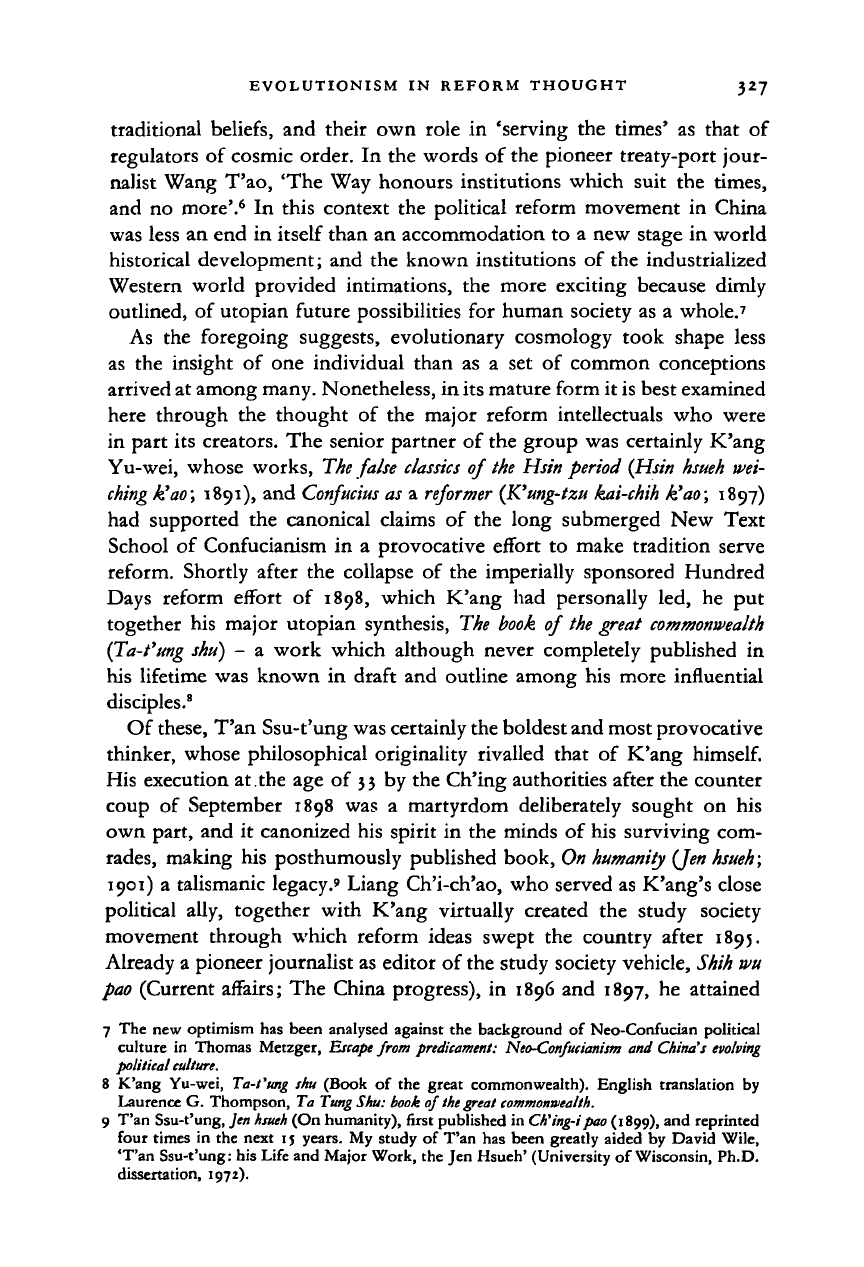
EVOLUTIONISM IN REFORM THOUGHT 327
traditional beliefs, and their own role in 'serving the times' as that of
regulators of cosmic order. In the words of the pioneer treaty-port jour-
nalist Wang T'ao, 'The Way honours institutions which suit the times,
and no more'.
6
In this context the political reform movement in China
was less an end in itself than an accommodation to a new stage in world
historical development; and the known institutions of the industrialized
Western world provided intimations, the more exciting because dimly
outlined, of Utopian future possibilities for human society as a whole.
7
As the foregoing suggests, evolutionary cosmology took shape less
as the insight of one individual than as a set of common conceptions
arrived at among many. Nonetheless, in its mature form it is best examined
here through the thought of the major reform intellectuals who were
in part its creators. The senior partner of the group was certainly K'ang
Yu-wei, whose works, The false
classics
of the Hsin period (Hsin hsueh wei-
ching
k'ao; 1891), and
Confucius
as a reformer (K'ung-tzu kai-chih k'ao; 1897)
had supported the canonical claims of the long submerged New Text
School of Confucianism in a provocative effort to make tradition serve
reform. Shortly after the collapse of the imperially sponsored Hundred
Days reform effort of 1898, which K'ang had personally led, he put
together his major Utopian synthesis, The
book
of
the
great
commonwealth
(Ta-t'ung shu) - a work which although never completely published in
his lifetime was known in draft and outline among his more influential
disciples.
8
Of these, T'an Ssu-t'ung was certainly the boldest and most provocative
thinker, whose philosophical originality rivalled that of K'ang
himself.
His execution at.the age of 33 by the Ch'ing authorities after the counter
coup of September 1898 was a martyrdom deliberately sought on his
own part, and it canonized his spirit in the minds of his surviving com-
rades,
making his posthumously published book, On
humanity (Jen
hsueh;
1901) a talismanic legacy.
9
Liang Ch'i-ch'ao, who served as K'ang's close
political ally, together with K'ang virtually created the study society
movement through which reform ideas swept the country after 1895.
Already a pioneer journalist as editor of the study society vehicle,
Shih rvu
pao (Current affairs; The China progress), in 1896 and 1897, he attained
7 The new optimism has been analysed against the background of Neo-Confucian political
culture in Thomas Metzger,
Escape
from
predicament:
Neo-Confucianism
and China's
evolving
political
culture.
8 K'ang Yu-wei, Ta-t'ung shu (Book of the great commonwealth). English translation by
Laurence G. Thompson, Ta
Tung
Shu:
book of
the great
commonwealth.
9 T'an Ssu-t'ung,
Jen hsueh
(On humanity), first published in Ch'ing-ipao (1899), and reprinted
four times in the next 15 years. My study of T'an has been greatly aided by David Wile,
'T'an Ssu-t'ung: his Life and Major Work, the Jen Hsueh' (University of Wisconsin, Ph.D.
dissertation, 1972).
Cambridge Histories Online © Cambridge University Press, 2008

328 INTELLECTUAL CHANGE, 1895-I92O
the peak of his influence as the editorial voice of the reform opposition in
Japanese exile after 1899.
If the foregoing three men had all staked their careers upon winning
reform under the monarchy
in
1898, paying
for
their failure with exile
or death, Yen Fu, the fourth great inspirer of the movement, maintained
a more temperate stand
on
the edge
of
events. Ostensibly the superin-
tendent
of a
naval academy
in
Tientsin,
he
was
a
rare British-trained
'foreign expert'
in
engineering. Rarer still, and unique to his generation,
was
his
synthetic view
of
contemporary Anglo-European civilization,
which he developed in a series of remarkable translations of major works
of Herbert Spencer, T. H. Huxley,
J.
S. Mill, Adam Smith, Montesquieu,
and others. Here he utilized the scholar's traditional convention of com-
mentary and the resources
of
the classical Chinese philosophical vocab-
ulary to present
a
dazzlingly interpretive rendition of his originals.
The complex intellectual relations among these four may be represented
by seeing K'ang and T'an as drawing most deeply upon native roots for
their philosophical synthesis, by contrast with the Western inspired Social
Darwinism of Yen Fu and Liang Ch'i-ch'ao. Such an analysis sees K'ang
and T'an tending
to
internationalism, reminiscent
of
the
t'ien-hsia
ideal
of
a
Sinocentric cosmos;
to
utopianism,
as
they projected the canonical
golden age
on to the
future, and
to
faith
in
the Confucian idea of Jen
(goodness)
as a
cosmic-moral principle. By contrast Yen
Fu
and Liang
Ch'i-ch'ao appear encouraged
by
their Social Darwinist orientation
to
take more nationalistic, pragmatic and secular perspectives. However,
before 1903
or
1904 the writings of all four displayed an underlying op-
timism about China's long-range prospects which belied the indignant
and anxious tones of their anti-imperialist, anti-court polemics, and which
is best understood as based upon
a
shared belief in the benign nature of
the metahistorical process as
a
whole, leading
to a
progressively realized
world community.
The major contribution
of
both the Ta-t'ung
shu
and the
Jen-hsueh
was
to present the idea of evolution integrated into a cosmology which linked
the process
of
evolutionary unfolding with social change. Both works
recognized
the
transvaluation
of
social values which
the
new stage
of
world history portended, while remaining confident that Confucian spirit-
ual truth would continue to be the metaphysical source
of
the pattern of
change.
Originally
New
Text Confucianism
had
provided K'ang Yu-wei
with
a
Chinese
schema
of
advancing historical stages which could
be
accommodated
to a
full-scale Western theory
of
progress. By means
of
this
he
embraced unilinear historical change with
the
enthusiasm
of a
Cambridge Histories Online © Cambridge University Press, 2008
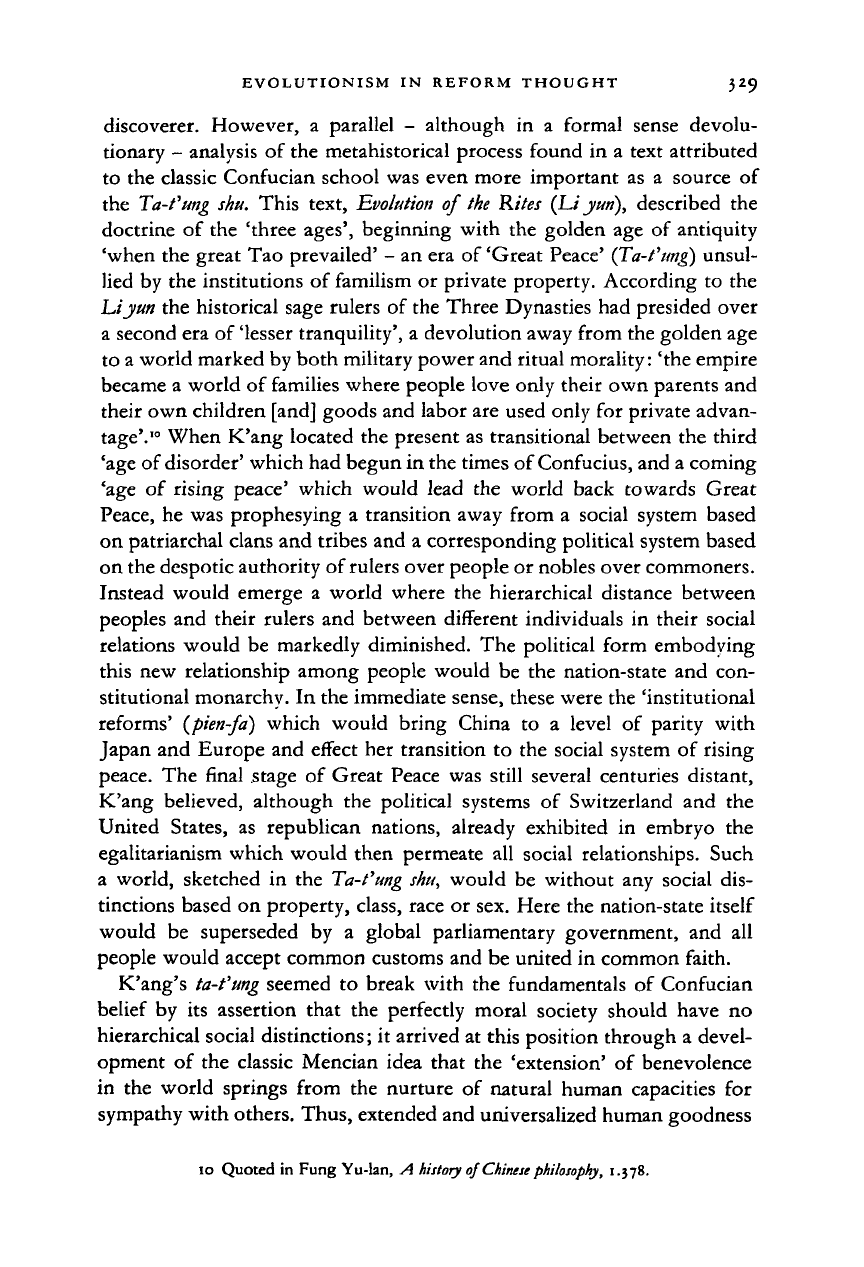
EVOLUTIONISM IN REFORM THOUGHT 329
discoverer. However,
a
parallel
-
although
in a
formal sense devolu-
tionary
-
analysis
of
the metahistorical process found
in a
text attributed
to
the
classic Confucian school was even more important
as a
source
of
the Ta-t'ung
shu.
This text,
Evolution
of
the
Rites (Li
yuri),
described
the
doctrine
of
the 'three ages', beginning with
the
golden
age of
antiquity
'when
the
great Tao prevailed'
- an
era
of
'Great Peace'
(Ta-t'ung)
unsul-
lied
by the
institutions
of
familism
or
private property. According
to the
Lijun
the
historical sage rulers
of
the Three Dynasties had presided over
a second era
of
'lesser tranquility',
a
devolution away from the golden age
to a world marked by both military power and ritual morality: 'the empire
became
a
world
of
families where people love only their own parents
and
their own children [and] goods and labor are used only
for
private advan-
tage'.
10
When K'ang located
the
present
as
transitional between
the
third
'age of disorder' which had begun in the times
of
Confucius, and a coming
'age
of
rising peace' which would lead
the
world back towards Great
Peace,
he
was prophesying
a
transition away from
a
social system based
on patriarchal clans and tribes and
a
corresponding political system based
on the despotic authority of rulers over people
or
nobles over commoners.
Instead would emerge
a
world where
the
hierarchical distance between
peoples
and
their rulers
and
between different individuals
in
their social
relations would
be
markedly diminished.
The
political form embodying
this
new
relationship among people would
be the
nation-state
and con-
stitutional monarchy.
In
the immediate sense, these were the 'institutional
reforms' (pien-fa) which would bring China
to a
level
of
parity with
Japan
and
Europe
and
effect
her
transition
to the
social system
of
rising
peace.
The
final stage
of
Great Peace
was
still several centuries distant,
K'ang believed, although
the
political systems
of
Switzerland
and the
United States,
as
republican nations, already exhibited
in
embryo
the
egalitarianism which would then permeate
all
social relationships. Such
a world, sketched
in the
Ta-t'ung
shu,
would
be
without
any
social
dis-
tinctions based
on
property, class, race
or
sex. Here
the
nation-state itself
would
be
superseded
by a
global parliamentary government,
and all
people would accept common customs and
be
united
in
common faith.
K'ang's ta-t'ung seemed
to
break with
the
fundamentals
of
Confucian
belief
by its
assertion that
the
perfectly moral society should have
no
hierarchical social distinctions;
it
arrived
at
this position through
a
devel-
opment
of the
classic Mencian idea that
the
'extension'
of
benevolence
in
the
world springs from
the
nurture
of
natural human capacities
for
sympathy with others. Thus, extended and universalized human goodness
10 Quoted
in
Fung Yu-lan,
A
history ofChinese
philosophy;
1.378.
Cambridge Histories Online © Cambridge University Press, 2008

}3° INTELLECTUAL CHANGE, 1895-I92O
becomes 'love'
(Jen),
which in K'ang's version was conceived as a dynamic
cosmic-moral energy. As such, it evinced itself in what he saw as the
power of attraction and repulsion inherent in the motions of the external
cosmos as well as in the surges of spontaneous 'attractive' sentiment
which underlie the moral life of conscious beings. During the age of
rising peace social norms, or //, still permitted a limited or 'partial' ex-
pression of human solidarity, by allowing for ethical distinctions between
near and far, or high and low; in the age of the great community social
customs would have cast off all such 'selfishness', and would perfectly
reflect a spirit of undifferentiated universal love (Jen).
Thus K'ang's model of natural and social evolution took off from the
historical transition from barbarism to civilization, and included a secular
vision of advanced democratic and affluent societies suggested by Western
examples. Yet fundamentally he believed that the whole process was an
odyssey of human spiritual perfection. Underpinning his prophecy of a
Utopia through modernization lay the traditional Neo-Confucian vision
of an organismic cosmos transformed through the self-actualization of
the sage's sincere mind. Yet K'ang's version suggested a novel relation-
ship between the poles of that organism: that is, between the sage on the
one hand and the external cosmos of 'Heaven and Earth' on the other.
Rather than placing sages in the centre as the source of cosmic transforma-
tions,
K'ang imagined them almost as spectators before the awesome
panorama of the universe. Jen, though still playing its role as the source
of the moral consciousness of the individual, manifested itself most
potently in the external sphere - in the starry heavens, in the dynamism of
change
itself.
From this came his orientation towards materialism, the
seeds of cosmological determinism, and a radical moral optimism. Gone
was the common Neo-Confucian tendency to anxiety over cosmic de-
ficiency and moral failure; instead K'ang breathed confidence that
spontaneous human desires are in harmony with
Jen,
and that personal
enjoyment, pleasure, abundance - all these as well as enlightenment were
to be expected bounties of the Utopia of the future. The sage would not
create social Utopia; history itself would. If the attainment of spiritual
perfection would come through the collapse of social barriers to human
community, K'ang imagined this less as the result of human struggle
than as a gift of liberation.
Therefore, this dream of the human conquest of selfishness appeared
devoid of any strong sense of the necessity of internal struggle to over-
come it. Indeed K'ang usually explained the obstacles to moral success
as arising from environmental and ritual 'barriers' external to the
self.
But he also defined moral action in practice as requiring in fact acceptance
Cambridge Histories Online © Cambridge University Press, 2008
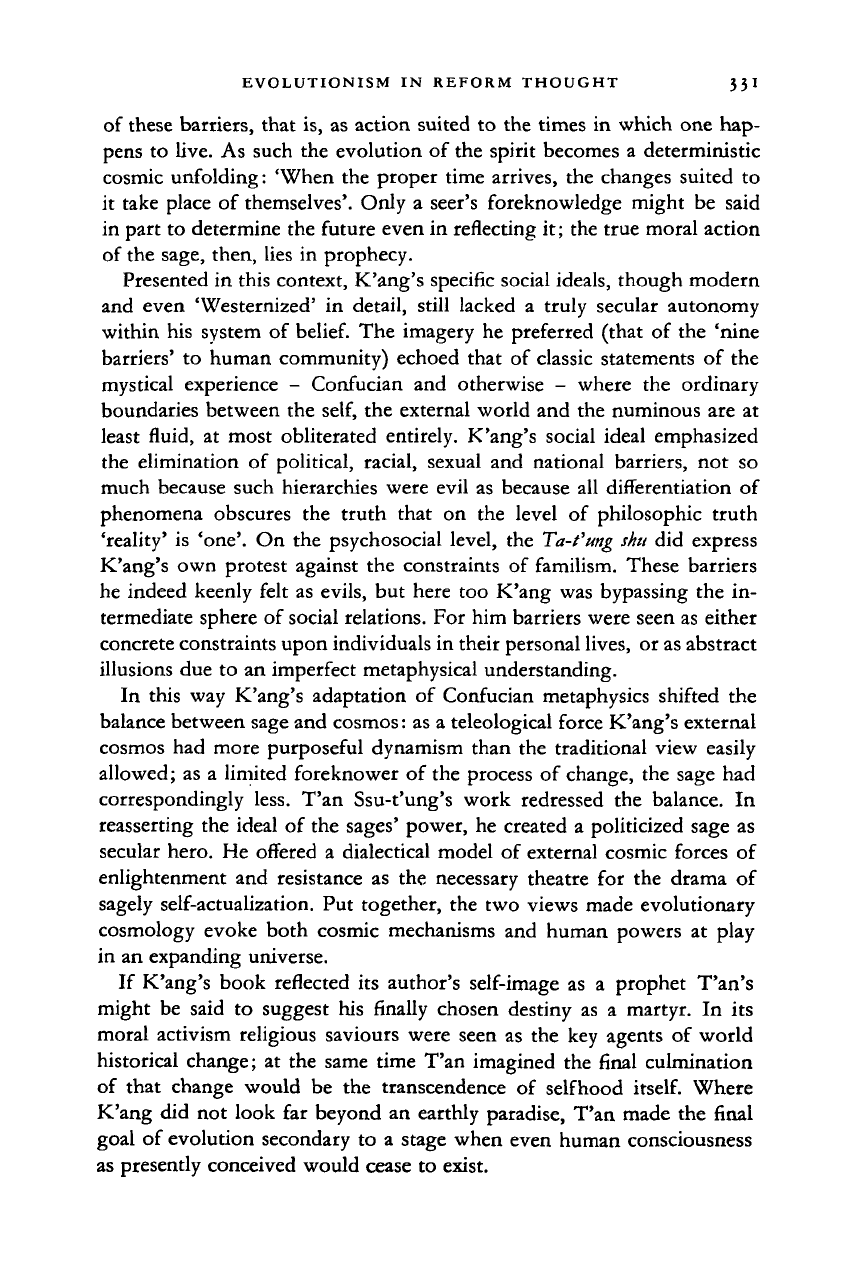
EVOLUTIONISM IN REFORM THOUGHT 331
of these barriers, that is, as action suited to the times in which one hap-
pens to live. As such the evolution of the spirit becomes a deterministic
cosmic unfolding: 'When the proper time arrives, the changes suited to
it take place of themselves'. Only a seer's foreknowledge might be said
in part to determine the future even in reflecting it; the true moral action
of the sage, then, lies in prophecy.
Presented in this context, K'ang's specific social ideals, though modern
and even 'Westernized' in detail, still lacked a truly secular autonomy
within his system of
belief.
The imagery he preferred (that of the 'nine
barriers' to human community) echoed that of classic statements of the
mystical experience - Confucian and otherwise - where the ordinary
boundaries between the
self,
the external world and the numinous are at
least fluid, at most obliterated entirely. K'ang's social ideal emphasized
the elimination of political, racial, sexual and national barriers, not so
much because such hierarchies were evil as because all differentiation of
phenomena obscures the truth that on the level of philosophic truth
'reality' is 'one'. On the psychosocial level, the Ta-t'ung shu did express
K'ang's own protest against the constraints of familism. These barriers
he indeed keenly felt as evils, but here too K'ang was bypassing the in-
termediate sphere of social relations. For him barriers were seen as either
concrete constraints upon individuals in their personal lives, or as abstract
illusions due to an imperfect metaphysical understanding.
In this way K'ang's adaptation of Confucian metaphysics shifted the
balance between sage and cosmos: as a teleological force K'ang's external
cosmos had more purposeful dynamism than the traditional view easily
allowed; as a limited foreknower of the process of change, the sage had
correspondingly less. T'an Ssu-t'ung's work redressed the balance. In
reasserting the ideal of the sages' power, he created a politicized sage as
secular hero. He offered a dialectical model of external cosmic forces of
enlightenment and resistance as the necessary theatre for the drama of
sagely self-actualization. Put together, the two views made evolutionary
cosmology evoke both cosmic mechanisms and human powers at play
in an expanding universe.
If K'ang's book reflected its author's self-image as a prophet T'an's
might be said to suggest his finally chosen destiny as a martyr. In its
moral activism religious saviours were seen as the key agents of world
historical change; at the same time T'an imagined the final culmination
of that change would be the transcendence of selfhood
itself.
Where
K'ang did not look far beyond an earthly paradise, T'an made the final
goal of evolution secondary to a stage when even human consciousness
as presently conceived would cease to exist.
Cambridge Histories Online © Cambridge University Press, 2008
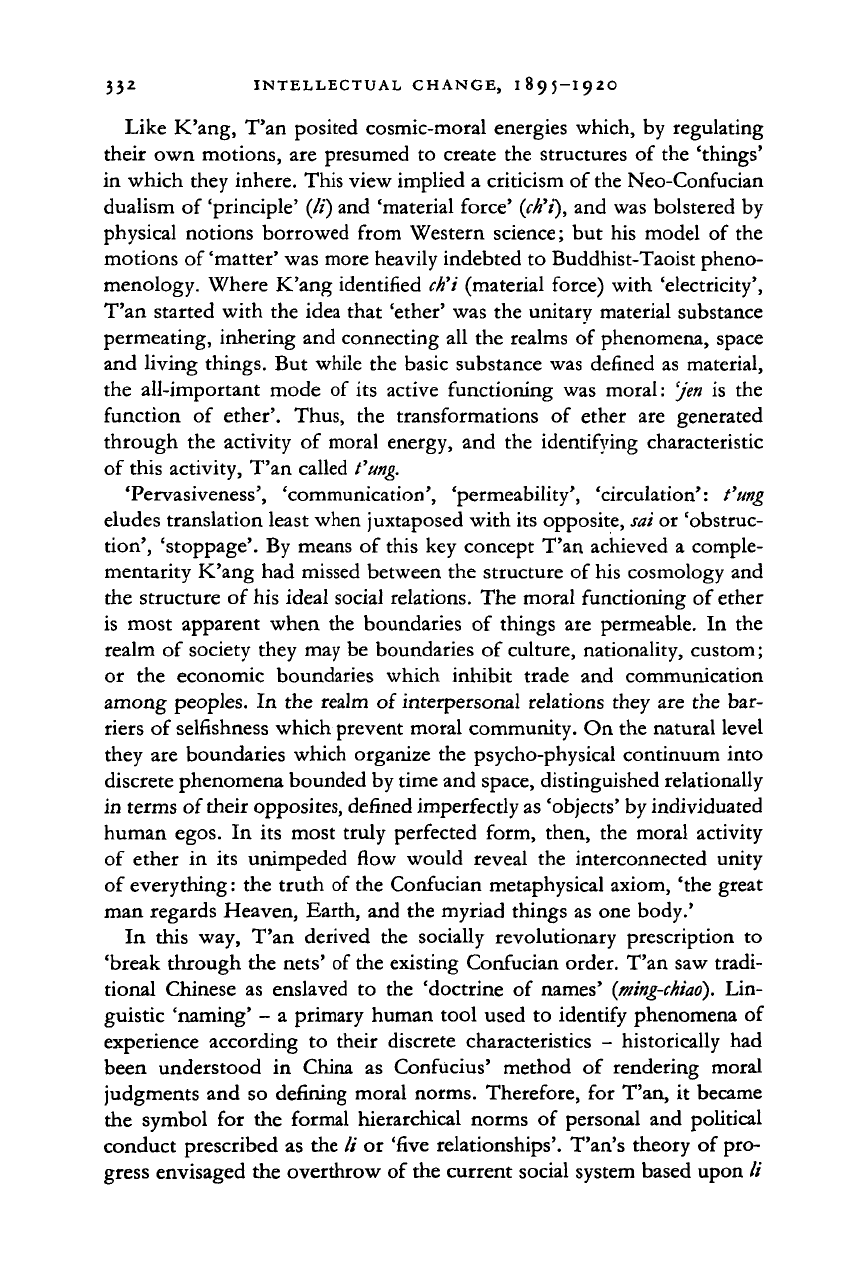
33
2
INTELLECTUAL CHANGE, 1895-I92O
Like K'ang, T'an posited cosmic-moral energies which, by regulating
their own motions, are presumed to create the structures of the 'things'
in which they inhere. This view implied a criticism of the Neo-Confucian
dualism of 'principle' (//) and 'material force'
(ch'i),
and was bolstered by
physical notions borrowed from Western science; but his model of the
motions of 'matter' was more heavily indebted to Buddhist-Taoist pheno-
menology. Where K'ang identified ch'i (material force) with 'electricity',
T'an started with the idea that 'ether' was the unitary material substance
permeating, inhering and connecting all the realms of phenomena, space
and living things. But while the basic substance was defined as material,
the all-important mode of its active functioning was moral: 'Jen is the
function of ether'. Thus, the transformations of ether are generated
through the activity of moral energy, and the identifying characteristic
of this activity, T'an called
t'ung.
'Pervasiveness', 'communication', 'permeability', 'circulation': t'ung
eludes translation least when juxtaposed with its opposite,
sat
or 'obstruc-
tion', 'stoppage'. By means of this key concept T'an achieved a comple-
mentarity K'ang had missed between the structure of his cosmology and
the structure of his ideal social relations. The moral functioning of ether
is most apparent when the boundaries of things are permeable. In the
realm of society they may be boundaries of culture, nationality, custom;
or the economic boundaries which inhibit trade and communication
among peoples. In the realm of interpersonal relations they are the bar-
riers of selfishness which prevent moral community. On the natural level
they are boundaries which organize the psycho-physical continuum into
discrete phenomena bounded by time and space, distinguished relationally
in terms of their opposites, defined imperfectly as 'objects' by individuated
human egos. In its most truly perfected form, then, the moral activity
of ether in its unimpeded flow would reveal the interconnected unity
of everything: the truth of the Confucian metaphysical axiom, 'the great
man regards Heaven, Earth, and the myriad things as one body.'
In this way, T'an derived the socially revolutionary prescription to
'break through the nets' of the existing Confucian order. T'an saw tradi-
tional Chinese as enslaved to the 'doctrine of names'
{ming-chiad).
Lin-
guistic 'naming' - a primary human tool used to identify phenomena of
experience according to their discrete characteristics - historically had
been understood in China as Confucius' method of rendering moral
judgments and so defining moral norms. Therefore, for T'an, it became
the symbol for the formal hierarchical norms of personal and political
conduct prescribed as the // or 'five relationships'. T'an's theory of pro-
gress envisaged the overthrow of the current social system based upon //'
Cambridge Histories Online © Cambridge University Press, 2008
